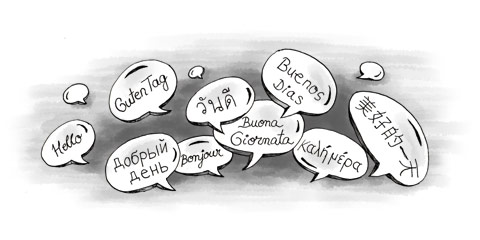Dialects or foreign languages are used by some 60 per cent of Italians and spoken exclusively by around 15 per cent of the population. However, although many Italians converse in dialect at home, they tend to speak italiano standard when travelling outside their home region or speaking to foreigners.
In reality, the universal language of Italy is sign language mainly using the hands (without which many Italians would be speechless), although the whole body is employed, including facial expressions.
The first languages of some 2.5 million or 5 per cent of the population are languages such as French, German and Slovene. Italy is home to a number of linguistic minorities, some of which have been granted special privileges in autonomous or semi-autonomous regions, and their language given equal status with Italian. These include French (Valle d’Aosta), German (Alto Adige) and Slovene (Friuli-Venezia Giulia), which are all official languages taught in state schools in these regions.
Franco-provençal or Arpitano French dialects are spoken in Valle d’Aosta, and in certain Piedmont valleys and in the upper Val Argentina (IM), Provençal or Occitanian dialects are spoken. Most German-speaking minorities (some 300,000 speak the Bavarian-Austrian dialect) live in the Province of Bolzano, while Slovenes are generally restricted to the Val di Resia (UD), the upper Torre and Natisone valleys, Val Canale, the eastern part of Gorizia province and most of the province of Trieste (a total of around 50,000). Several groups speaking Serbo-Croat are found in Molise while Croatian, the smallest minority language spoken by some 2,000 people, has survived in Campobasso province in Molise.
Albanian-speaking colonies are concentrated mainly in Sicily and Calabria, but are also found in Molise, Abruzzo, Campania, Puglia and Basilicata, some of whom (descended from 15th century Albanian mercenaries) speak a dialect of Albanian known as Arbëresh.
There are Catalan-speaking groups in the town of Alghero in the north-west of Sardinia, dating from the island’s capture by the crown of Aragon in 1354. Greek dialects are spoken in some parts of Calabria and Puglia. There are also gypsies who speak the Sinti dialect in the north and the Rom dialect in the centre and south of the country.
The main Italian dialects are Sardo (circa 1,350,000 speakers), Friulano (circa 700,000 speakers) and Ladin (circa 40,000 speakers). Sardo, spoken in Sardinia, is virtually another language entirely, similar to Catalan and dating back to Spanish rule. Variations in dialect can be particularly strong and include Ligurian (which employs a mixture of Italian, Catalan and French), Neapolitan and Sicilian.
Italian is one of the romance languages and is a beautiful tongue that’s relatively easy to learn, particularly if you already know some French or Spanish (or Latin) – and have many hands. The Catholic Church still uses Latin as the official liturgical language and it’s still taught in Italian schools from the 6th grade upwards (with the exception of technical establishments).
Modern Italian is a descendant of ‘vulgar’ spoken Latin and was standardised in the late Middle Ages (14th century) by the literary triumvirate of Boccaccio, Dante and Petrarch, who wrote mainly in the Florentine dialect, which subsequently became the basis for today’s standard Italian (italiano standard). This is the language taught in schools and used in the media, although it’s often mixed with dialects. However, standard Italian has been in widespread use only since the unification of Italy in the 1860s and Italians were slow to adopt the language of the new nation-state, identifying much more strongly with their regional dialects.
Those interested in the Italian language may like to check the Italian language website (www.italianlang.org ) and http://italian.about.com .
This article is an extract from Living and Working in Italy from Survival Books.


